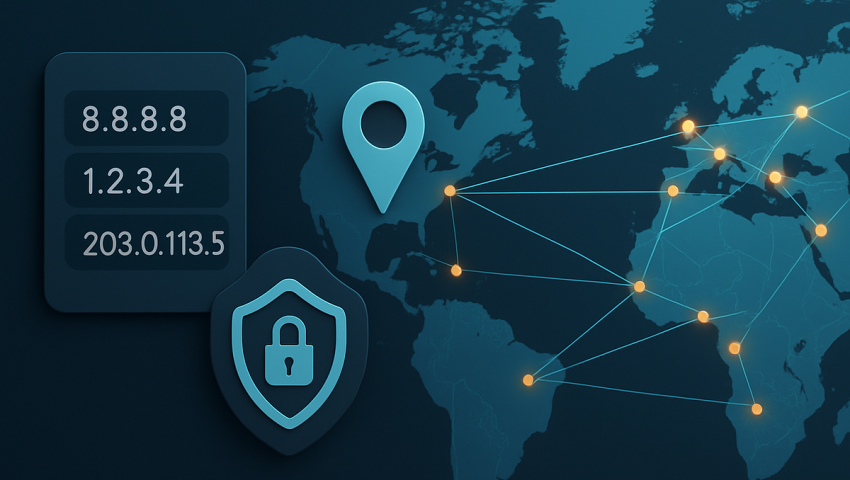
How IP Geolocation Works: Tools & Techniques for Cyber Investigators
IP geolocation is a cornerstone of cyber investigations. Learn how it works, its critical limitations, and the advanced techniques investigators use to pinpoint a suspect's location.
An IP address is the first piece of digital breadcrumb left behind in nearly every online interaction. For a cyber investigator, it’s the starting pistol for the hunt. The immediate question is: "Where is this?"
The process of answering that question is called IP geolocation. It's a powerful technique, but it's often misunderstood. This isn't about getting a precise GPS coordinate; it's about building a probabilistic picture of a device's location. For investigators, knowing how this works—and, just as importantly, how it doesn't —is crucial to avoiding dead ends and building a solid case.
Part 1: The Basics - What is an IP Address?
Before we can geolocate, we need to understand what we're working with.
An IP (Internet Protocol) address is a unique numerical label assigned to every device connected to a network. Think of it as the return address on a postal letter. There are two main types:
IPv4: The most common format (e.g., 192.168.1.1 ). The pool of these addresses is exhausted.
IPv6: A newer format designed to provide a vastly larger number of addresses (e.g., 2001:0db8:85a3:0000:0000:8a2e:0370:7334 ).
Crucially, an IP address is assigned to a device's connection to the internet, not necessarily to the device itself. This is the source of both its utility and its limitations.
Part 2: How IP Geolocation Works - The Data Sources
IP geolocation databases don't use magic. They build their maps by aggregating data from several sources. The accuracy depends entirely on the quality and quantity of this data.
1. Regional Internet Registries (RIRs)
What it is: There are five RIRs globally (e.g., ARIN for North America, RIPE NCC for Europe) that allocate large blocks of IP addresses to Internet Service Providers (ISPs) and large organizations.
The Data: RIRs maintain public databases (WHOIS) that list which organization owns a specific IP block. This provides a company-level location, often the ISP's headquarters, which might be in a different city or state from the actual user.
2. Data from Internet Service Providers (ISPs)
What it is: This is where accuracy improves. ISPs assign IP addresses to their customers from their allocated blocks. They know which customer got which IP at what time.
The Data: Geolocation database companies often have agreements with ISPs or infer data from network patterns. This can narrow the location down to a city or even a neighborhood.
3. Voluntary User Data & Crowdsourcing
What it is: This is one of the most effective methods. When millions of users on devices with actual GPS (like smartphones) use apps or services, they can voluntarily share their precise location alongside their IP address.
The Data: Companies like Google and MaxMind aggregate this data. If hundreds of devices with GPS coordinates are using the same IP address, the geolocation for that IP can be very accurate—often to the city or postal code level.
4. Network Measurement Data
What it is: Techniques like latency measurement (how long a data packet takes to travel) and traceroute (mapping the path a packet takes) can estimate distance. A short latency to a server in Dallas suggests the user is likely closer to Dallas than to Tokyo.
The Data: This helps triangulate a general region and validate other data sources.
Part 3: Essential IP Geolocation Tools for Investigators
Investigators use a combination of free lookup tools and powerful commercial platforms.
Free Lookup Tools (For a Quick Start)
MaxMind GeoIP2 / GeoLite2: The industry standard. Offers a free Lite database that is surprisingly accurate for city-level data. Perfect for initial triage.
IPinfo.io : Provides a clean API and detailed information, including the ISP and whether the IP is associated with a hosting provider or VPN.
WhatIsMyIPAddress.com / IPLocation.net: User-friendly websites that provide a quick overview of an IP's estimated location, ISP, and abuse contact information.
Commercial & Investigative Platforms (For Deep Dives)
MaxMind GeoIP2 Precision: The paid version of their service offers significantly higher accuracy, especially for mobile carriers, and more detailed data points like connection type and domain.
Digital Envoy: A leading provider of IP intelligence used by major companies for ad targeting and fraud prevention. Their data is highly refined.
Threat Intelligence Platforms (e.g., Recorded Future, ThreatConnect): These platforms integrate IP geolocation with other threat data, showing if an IP is associated with known malicious activity, botnets, or other threats.
Part 4: Critical Limitations & Challenges for Investigators
This is the most important section. Relying solely on a geolocation lookup is a classic rookie mistake.
| Challenge | Why It Matters for Investigators |
|---|---|
| VPNs (Virtual Private Networks) | A VPN masks the user's real IP address, replacing it with an IP from the VPN provider's server. The geolocation will point to the VPN server, which could be in another country. Always check if an IP belongs to a known VPN provider. |
| Proxies & TOR (The Onion Router) | Like VPNs, these services route traffic through multiple relays, obscuring the true origin. A TOR exit node's IP is what you'll see, and it has no relation to the user's location. |
| Mobile Networks (3G/4G/5G) | Your phone's IP address on a mobile network is often assigned from a central pool. You might be in Los Angeles, but your IP could be geolocated to your carrier's core network in Texas. |
| Public Wi-Fi & Hotspots | An IP from a coffee shop, airport, or library only places the user at that public location at a specific time. It is rarely sufficient to identify an individual without additional evidence (like CCTV or purchase records). |
| Stolen IPs & Spoofing | Sophisticated attackers can hijack or spoof IP addresses, making it appear that traffic is coming from an innocent third party. |
Part 5: Advanced Investigative Techniques
The pros don't just stop at a lookup. They build a case.
Correlate with Timestamps: An IP geolocated to New York being used at 2 AM local time is less suspicious for a user also in New York than for one in London (where it would be 7 AM). Correlate the activity time with the geolocation's time zone.
Identify the ISP and Send a Legal Request: This is the definitive step. Once you have the ISP and the timestamp of the activity, you can work with legal counsel to issue a subpoena or preservation request to the ISP. The ISP can then provide the subscriber information (name, address) associated with that IP address at that specific date and time.
Combine with Other Intelligence: Use the IP as a pivot point.
Domain History: Has this IP address hosted other malicious websites?
Historical Data: Use a tool like WhoisHistory.org to see if the IP was previously associated with a different, more revealing organization.
Open Ports/Services: Scan the IP (legally and ethically!) to see if it’s running services that provide clues (e.g., a default router login page might reveal a specific ISP or model).
Disclaimer: Always ensure you have the proper legal authority before investigating an IP address. Unauthorized scanning or harassment is illegal.
Mrityunjay Singh
Leave a comment
Your email address will not be published. Required fields are marked *

